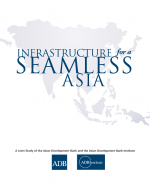The Greater Mekong Subregion: Rural No More
The subregion is one of the least urbanized areas in the world, but its cities are growing and their economic impact is being felt.
The subregion is one of the least urbanized areas in the world, but its cities are growing and their economic impact is being felt.
Special economic zones combined with economic corridors are a potent force for prosperity in the Greater Mekong Subregion.
Thailand is rolling out an ambitious plan to transform the eastern part of the country into an investment, technology, and transportation hub, where all the economic corridors of the Greater Mekong Subregion converge.
In Kunming, governors and key local government officials from provinces along the borders of the Greater Mekong Subregion came together on 10 June 2017 to discuss further cooperation.
Vulnerable towns in Cambodia, Lao People’s Democratic Republic, and Viet Nam are using “green infrastructure” to stave off the impacts of climate change.
The Myanmar government recently approved a project that will ensure the completion of the Greater Mekong Subregion East-West Economic Corridor, which stretches from Danang, Viet Nam to Yangon, Myanmar.

This publication outlines the GMS Economic Cooperation Program (GMS Program) which was initiated in 1992 with the support of ADB. It aims to promote economic cooperation among Cambodia, People's Republic of China (PRC), Lao People's Democratic Republic (Lao PDR), Myanmar, Thailand, and Viet Nam.
The GMS Program covers nine priority sectors: transportation, telecommunications, energy, environment, human resource development, trade, investment, tourism, and agriculture.

Flagship study that analyzes major challenges in developing regional infrastructure, particularly transport and energy through regional cooperation towards a seamless Asia.
PHNOM PENH, CAMBODIA (4 August 2011) - Countries in the Greater Mekong Subregion (GMS) are poised to move the GMS Economic Cooperation Program into a second generation of initiatives over the next 10 years.
VIENTIANE, LAO PDR (30 June 2011) – Progress in developing the economic corridors in the Greater Mekong Subregion will be a key indicator of the success of the GMS Economic Cooperation Program, delegates at today's Third Economic Corridors Forum meeting heard.